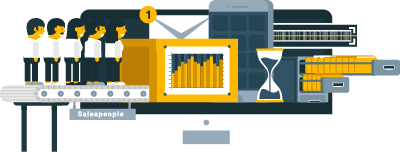Talk to Sales: (401) 200-6026

When you’re running a dealership, business expenses are always going to be there—but it’s up to you to determine how much you’re willing to spend.
Peter has a reputation around town as a savvy dealership business owner. He’s the top-selling auto dealer in his county, is known for his inventory of high-demand vehicles, and the customer service scores for his employees are off the charts. In addition to that, he spends a pretty penny on all types of advertising and has become a bit of a local legend for his one-of-a-kind television commercials.
From the outside, Peter appears to be doing everything right. He’s the envy of other local dealership owners; they all wonder what he’s doing to make so much money.
The truth? Peter’s profits are abysmal. He wants only the best for his dealership business—the best cars, employees, advertising—and he’s willing to spend big money to make that happen. Unfortunately, he’s spending too much, and his expenses aren’t in sync with his gross profits.
He likes to reason that, “You gotta spend money to make money!” but he has to get a grip on his expenses before his business implodes.
Your situation may not be as dire as Peter’s, but if you think there’s room to trim your dealership costs, you’re probably right. Even if you think your input versus output is a well-oiled machine, it’s certainly worth your time to look at your books and see where you may be able to reduce your expenses–you could be very surprised.
Where to start making your dealership business more profitable
“Someone in your organization has to get into the weeds with your expenses…if not, you are clearly leaving as much as 25% on the table day after day, week after week, month after month, and year after year,” writes Doug Austin, founder and President of StrategicSource, Inc.
First, look at a month-by-month income statement for the last year of business. This spreadsheet will allow you to compare your sales, cost of sales, gross profits, and expenses. Do you notice any trends?
Now, you’re going to want to start digging deep into your expenses. These costs should be separated into two different groups because not all expenses are created equal. You’ll have:
1. Variable expenses
Expenses directly related to sales and inventory carrying costs. These should change proportionately to your sales and gross profits.
Types of variable expenses may include floor plan interest, demo expense, delivery expense, advertising, personnel, employee benefits, absentee wages.
2. Fixed expenses
These expenses remain pretty consistent month after month.
Types of fixed expenses include office and shop supplies, credit card interest, legal, postage, repairs and maintenance, insurance, utilities.
Once you’ve narrowed down your expenses for the last year, don’t just skim over the numbers to see if everything “looks good.” You need to take each category, one by one, and evaluate the money that was spent and why. If you’ve never done this before, you’re probably going to find a lot of areas that you could easily reduce without affecting your normal flow of business.
Dealership business expense categories with room to trim
Where you ultimately choose to reduce costs will depend on your individual dealership, but here are some common areas where others may cut back:
1. Advertising
Advertising is essential when you’re running a dealership, but it needs strategic management. You can’t just throw money into commercials, print ads, and pay-per-click ads without also measuring results and ROI. You love producing your TV commercials, but you may find that the numbers aren’t adding up and they simply aren’t bringing in the amount of business they need to.
2. Personnel
Don’t go firing anyone, but an easy area to save money is by watching how much overtime your employees are clocking. Have management sign off on all overtime before it goes to payroll. Also, be smart about who you hire. Dealerships tend to have a lot of turnover, and that gets expensive–try to minimize that as much as possible by taking the time to hire the right people.
3. Office and shop supplies
How can you reduce the cost of supplies if you need them to do business? Two simple ways are to shop around for discounts and keep supplies locked up at all times–appoint specific employees to be keyholders. Employees can sometimes get sticky fingers, especially when it comes to office supplies–“who’s going to miss an envelope?!”–but the costs add up over time and can impact your bottom line.
4. Inventory
Those used cars sitting on your lot cost you money every single day. A 60-day rule on your lot could help (though it should preferably be 30 days) so your inventory keeps moving, but your money doesn’t.
You’re going to find that by taking the time to review your expenses and tightening the purse strings a little, your dealership business profits will vastly improve without too much effort.
5. Revising Vendor Contracts and Streamlining Business Processes
Another practical avenue to explore for cutting costs is to renegotiate your vendor contracts. Be it the IT support services, janitorial services, or vehicle maintenance equipment, there’s a good chance that you can find a more competitive rate than what you’re currently paying. By leveraging the prospect of a long-term relationship, you may be able to negotiate better terms with your current providers, or switch to a cheaper vendor that can deliver the same quality of services.
Streamlining your business processes is another great way to cut costs. By identifying inefficiencies and redundancies in your operations, you can devise methods to increase productivity while reducing overhead. For example, using dealership management software can automate a lot of tasks, minimizing errors and freeing up valuable time that can be better utilized. Digitalizing your documentation process, for instance, can help save costs on paper and printing, as well as make retrieving and sharing information more efficient.
6. Reevaluating Marketing Strategies
Digital marketing presents a cost-effective alternative to traditional advertising mediums like television commercials or print ads. According to Google, 95% of car buyers use digital as a source of information. Hence, shifting your marketing efforts towards channels like social media, search engine optimization (SEO), and email marketing could yield substantial savings.
Moreover, digital platforms offer advanced analytics tools, allowing you to track the performance of your campaigns and fine-tune your marketing strategies based on data-driven insights. By focusing on high-performing channels and eliminating underperforming ones, you can significantly reduce your advertising expenses while still reaching your target audience effectively.
7. Investing in Employee Training and Development
While this might seem counterintuitive, investing in your employees can lead to cost savings in the long run. Properly trained employees are more efficient, make fewer mistakes, and provide better customer service, leading to more sales and less waste. Additionally, providing opportunities for growth and development can increase employee loyalty and reduce turnover, which can save significant costs related to hiring and training new employees.
8. Reducing Energy Usage
Energy costs are another area where you can potentially save. Implementing energy-saving measures like using energy-efficient lighting, insulating your buildings, and encouraging employees to turn off equipment when not in use can lead to substantial savings over time. Investing in renewable energy sources like solar panels can also yield significant returns in the long run, and they’re beneficial for the environment too.
9. Implementing Preventive Maintenance
Preventive maintenance of your dealership’s equipment and infrastructure can save you from costly repairs and replacements in the future. Regular maintenance can prolong the lifespan of your assets and ensure they’re running at optimal efficiency. This can be as simple as regular oil changes and tire rotations for your demo vehicles, or timely servicing of your HVAC systems and other utilities.
Driving Profitability by Streamlining Car Dealership Expenses
Reducing dealership expenses isn’t just about cutting costs—it’s about optimizing your resources to achieve the best results. With careful analysis and strategic planning, you can significantly reduce your expenses without compromising on the quality of service you provide to your customers. This way, you not only improve your dealership’s profitability but also its sustainability in the long run. Remember, every penny saved is a penny added to your bottom line.
Interested in an Affordable, Full-Featured Auto Dealer CRM?
Schedule an AutoRaptor Demo Now!



